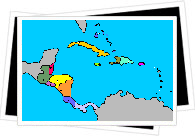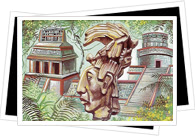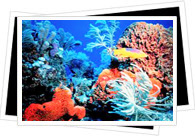
Central America comprises the countries below the USA in the North American peninsula which include Belize, Costa Rica, El Salvador, Guatemala, Honduras, Nicaragua and Panama.
Most countries run according to Central Standard Time, which is 6 hours behind GMT with flight times from Europe starting from 10.5 hours and from 3 hours when visiting from the USA, depending on your location.
The Caribbean Sea area has a sporadic history of earthquakes and volcanic eruptions which have provided fertile farmland areas to support the 42 million inhabitants of the region. The geography of Central America is mountainous with most people living in the valleys and the main crops produced are coffee, cocoa, bananas, beans and corn. The area is home to an abundancy of wildlife, including 9% of the world's coral reef.

It is believed that the inhabitants of the Americas came from Siberia during the last ice age and eventually moved southwards, travelling between the years 60,000 and 8,000BC over land which is now below the Bering Strait. Before Christopher Columbus discovered the Americas, the native people, called the Maya, occupied much of the area. They were skilled as farmers in a relatively dry area and also as craftspeople, producing elaborate murals and ceramics.
The Maya began to decline about 1000 years ago and the Aztec people prospered, particularly in the area of modern day Mexico City. The Aztecs too were great farmers and also very creative, enjoying festivals of songs, poetry, plays and acrobatics, but are probably most well known as being supporters of human sacrifice which featured heavily within their religious culture.
Approximately 70% of the region's current population are Mestizo, a mixed race of Colonial and indigenous ancestry. For almost 300 years following the arrival of Christopher Columbus and the Spanish forces, Spain was the controlling influence in most countries of the region (the exception being modern day Belize, which was under British control until 1981) in what is known as the Colonial Period.

When paying a visit to Central America for the first time, many are surprised at how 'undiscovered' the area still feels. The 20th century was one of revolutions as the region modernized its transportation, economy and social infrastructure, so tourism has been welcomed with a variety of sights and sounds for the visitor to explore: beaches of white sands and diving opportunities in the warm temperatures of the Caribbean Sea, visits to coffee plantations to learn about how one of the world's favourite drinks ends up in our morning cuppa, strolls through towns with Colonial architecture and museums, trekking through the jungles to find Mayan pyramids listed as world heritage sites or marvelling at the wildlife and geography of the national parks.